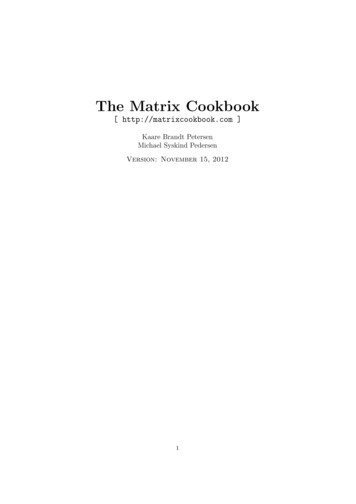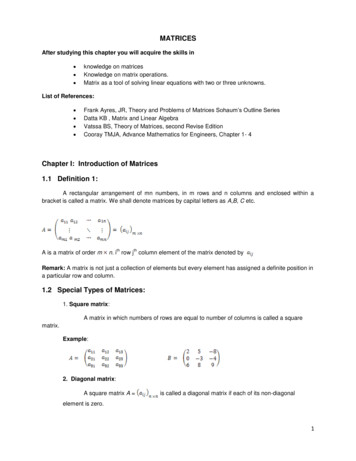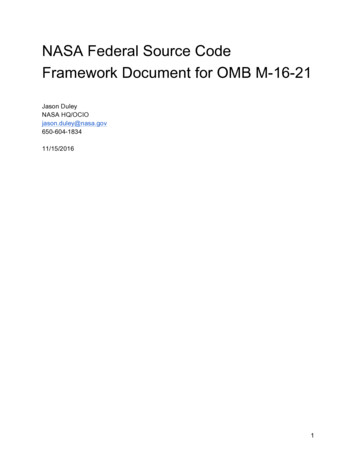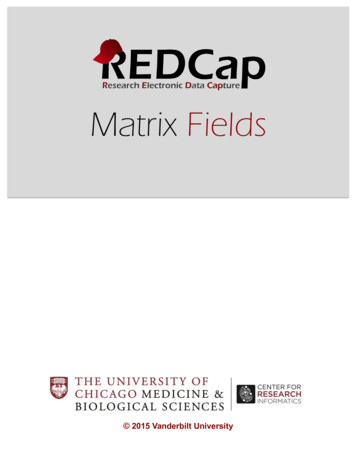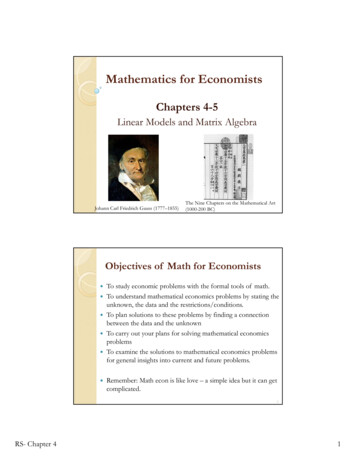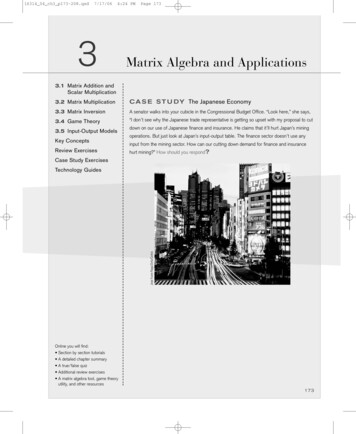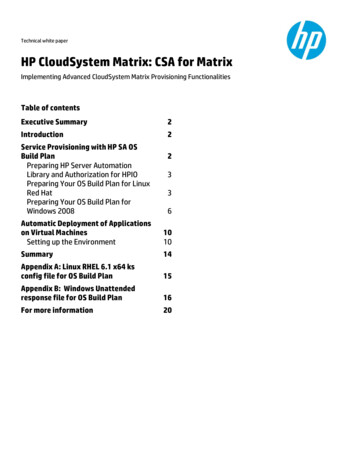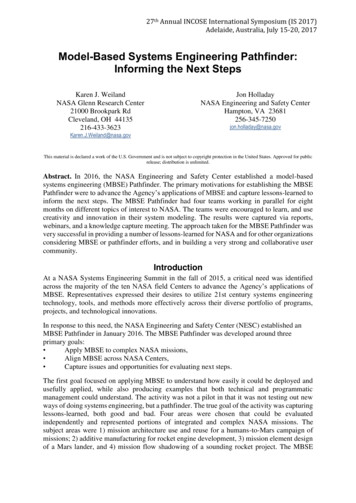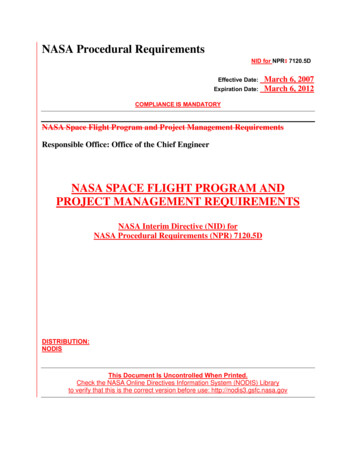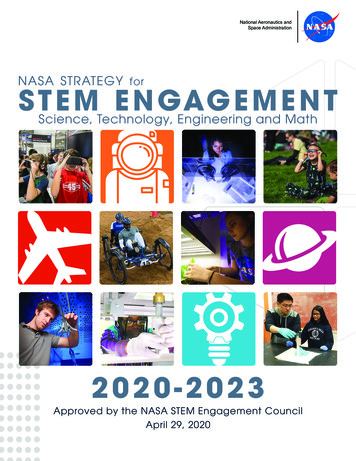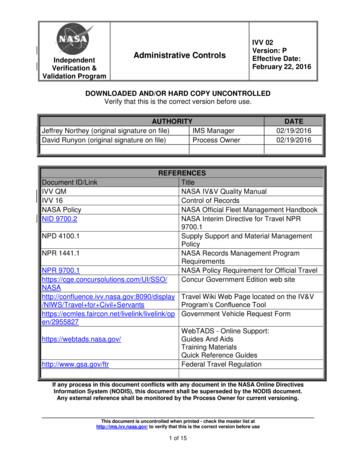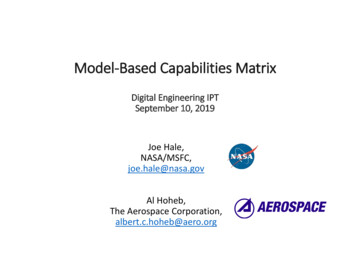
Transcription
Model-Based Capabilities MatrixDigital Engineering IPTSeptember 10, 2019Joe Hale,NASA/MSFC,joe.hale@nasa.govAl Hoheb,The Aerospace Corporation,albert.c.hoheb@aero.org
Agenda INCOSE Challenge Team Effort Developmental History (abbreviated) Overview of the Matrix Structure, Products andTailoring Matrix Uses Concept of Operations
INCOSE Challenge Team Effort Co-Leads: Joe Hale, NASA/MSFC, joe.hale@nasa.gov Al Hoheb, The Aerospace Corporation/SED, albert.c.hoheb@aero.org INCOSE Challenge Team: Federation of those willing to assist in the development and deployment of theproducts; now 139 and growing Model-Based Capabilities Matrix (MBCM) INCOSE Challenge Team Technical ProjectPlan (TPP) version 2.2 Approved Two products: MBCM and User’s Guide Resources: OMG Wiki: http://www.omgwiki.org/MBSE/ The OMG wiki entry discusses the effort. http://www.omgwiki.org/MBSE/doku.php?id mbse:mbecm INCOSE Connect, workgroups, Model-Based Capabilities Matrix (INCOSE Members only). Thisis the INCOSE member download area for the matrix and User’s Guide.
Developmental History (abbreviated) The story begins with two independent efforts to provide a reference for enterpriseand program/project organizations to assess their current and desired implementationof modeling NASA MSFC MBSE Maturity Matrix The Aerospace Corporation MBSE Community Roadmap Following a presentation of both at the OSD Digital Engineering Working Group, it wasdecided to combine these efforts to develop a comprehensive Model-Based EnterpriseCapability Matrix Early drafts of the Matrix and User’s Guide were presented at a series of Workshops atvarious System Engineering fora: INCOSE International Workshop (Jan 2018) Where the INCOSE Challenge Team was formed to produce a candidate INCOSETechnical Product Aerospace System Engineering Forum (May 2018) INCOSE International Symposium (July 2018) NDIA SE Conference workshop (Oct 2018) INCOSE International Workshop (Jan 2019) Aerospace System Engineering Forum (Feb 2019) INCOSE International Symposium (July 2019) (received final comments/mods) Updated Products and submitted final version to INCOSE Tech Pubs August 29, 2019
INCOSE Challenge Team Reps from numerousOrganizations, including: Japan Aerospace Exploration Agency (JAXA) Raytheon The Aerospace Corporation Harris Corp. Office of the Secretary of Defense (OSD) Northrup-Grumman Booz Allen Hamilton BAE Systems Various NASA Centers LaRC, GRC, GSFC, MSFC, JPL, JSC Space and Naval Warfare Systems Command(SPAWAR) US Navy General Atomics US Air Force Draper National Defense Industrial Association(NDIA) Ford Boeing Dassault Systemes Mitre MIT Thales National Institute of Standards andTechnology (NIST) Airbus Lockheed Martin
Overview of the Matrix Structure, Products andTailoring
Matrix Structure Rows: Organization modeling capabilities for an organization Role-Based view or Digital Engineering (DE) goal view – same capabilities Each view has the capabilities sorted by the role-based or DE goal key field Columns: Increasing Stages of Capability generally defined as:Stage 0: No MBSE capability or MBSE applied ad hoc to gain experienceStage 1: Modeling efforts are used to address specific objectives and questionsStage 2: Modeling standards are applied; ontology, languages, tools,Stage 3: Program/project wide capabilities; model integrated with other functional disciplines,digital threads defined and digital twin Stage 4: Enterprise wide capabilities: contributing to the enterprise, programs/projects useenterprise defined ontologies libraries, standards CapabilitiesCap 1Cap 2Cap 3Cap 4Stage 0Stage 1Stage 2Stage 3Stage 4
Products Model-Based Capabilities Matrix (MBCM) version 2.0d1 Two views; Role-based view, and OSD Digital Engineering Strategy goal view Same capabilities allocated differently for the 2 views Prints on 3 pages of 11”X17” paper The role-based areas are: Workforce/CultureSystem Engineering Processes/MethodologyProject/Program Process/MethodologyModel Based EffectivenessModeling Tool ConstructionInformation Technology InfrastructurePolicy OSD DE Strategy Goals are: Use of ModelsAuthoritative Source of Truth (ASOT)InnovationEstablish EnvironmentsWorkforce TransformationUser’s Guide version 5.2f1 Includes Frequently Asked Questions (FAQs) (useful for newcomers)
Snapshot of Matrix – Role Based ViewCapability Descriptionshave been addedColumn B “DE Goals” is hidden“Role-Based capabilities definition handout”“Role-Based View”Example “Role-Based Print Layout”“DE Goals-Based View”“DE Goals and Focus Areas”
Tailoring Use language that is important to the organization E.g., NASA uses “project,” DoD uses “Program” Identification of individual SE processes to beaddressed that are critical to success E.g. CM/DM Addition/deletion of rows to focus on organizationperspective
Matrix Uses
Matrix Uses: Strategic Vision Objective: Define a future state description of one or more domains/attributes of a matureModel-Based Enterprise General Approach: Derive a tailored vision based on the most relevant mature attributedescriptions in the left-most column. Example: Selected Tools & IT Infrastructure attributes are the relevant attributes for thisexampleModel-Based CapabilityStagesTools & IT InfrastructureStage 0Stage 1Stage 2Stage 3Stage 4E-mail, telecom.System Model File Exchange.Various organizations working onPartial On-line, real-timedifferent parts of model. Fullcollaboration amongstmodel integrated by a singleorganizations.distributed teamsNoneTool-to-Tool, ad hocinteroperabilityPartial Federated DatabaseManagement System (FDBMS)Main tools interoperable.Supporting tools interactthrough file transfer.Inter-Database/Tool Data Item Databases/tools are Inter-Database/Tool Data ItemAssociationsindependentassociations definedInter-Database/Tool Data Itemassociations defined, captured,managedInter-Database/Tool Data Itemassociations among all data itemsInter-Database/Tool Datadefined, captured, managed, andItem associations among all traceable where changes in onedata items defined, captured, data source alerts owners of othermanaged, and traceabledata sources of intended updatesUser IF, Viewpoint/ViewsUI draws from Model appUI draws from multiplemodels/DBsCollaborationDisparate Database/ToolinteroperabilityN/ADoc GenOn-line, real-time collaborationamongst distributed teamsFully Federated w/ standard "plugand-play" interfaces. Data isinterchanged among toolsUI supports Interrogation; multipleconfigs The Stage 4 column gives the mature attribute descriptions for the relevant attributes A Vision statement might be: We aim to provide a fully Federated IT architecture with: Standard "plug-and-play" interfacesManaged data item relationships across heterogenous, disparate data sourcesUser Interfaces that enable navigation and interrogation across heterogenous, disparate data sources,andOn-line, real-time collaboration amongst distributed teams
Matrix Uses: Roadmap Objective: Define a Roadmap of increasing capability of one or moredomains/attributes towards a mature Model-Based Enterprise General Approach: Derive a tailored roadmap based on one or morerelevant attribute rows. Example: Selected Tools & IT Infrastructure attributes are the relevantattributes for this exampleModel-Based CapabilityStagesTools & IT InfrastructureCollaborationDisparate Database/ToolinteroperabilityStage 0Stage 1Stage 3Stage 4E-mail, telecom.System Model File Exchange.Various organizations working ondifferent parts of model. FullPartial On-line, real-timecollaboration amongstmodel integrated by a singledistributed teamsorganizations.NoneTool-to-Tool, ad hocinteroperabilityPartial Federated DatabaseManagement System (FDBMS)Main tools interoperable.Supporting tools interactthrough file transfer.Inter-Database/Tool Data Itemassociations defined, captured,managedInter-Database/Tool Data Itemassociations among all data itemsInter-Database/Tool Datadefined, captured, managed, andItem associations among all traceable where changes in onedata items defined, captured, data source alerts owners of othermanaged, and traceabledata sources of intended updatesUI draws from Model appUI draws from multiplemodels/DBsInter-Database/Tool Data Item Databases/tools are Inter-Database/Tool Data Itemindependentassociations definedAssociationsUser IF, Viewpoint/ViewsStage 2N/ADoc Gen Roadmap for tool interoperability and traceability:On-line, real-time collaborationamongst distributed teamsFully Federated w/ standard "plugand-play" interfaces. Data isinterchanged among toolsUI supports Interrogation; multipleconfigs Milestone 1: Some tool-to-tool integration; cross-tool data associations defined Milestone 2: Demonstration of selected tools in a Federated Architecture; cross-tool dataassociations defined, captured, managed Milestone 3: Main tools interoperable in a Federated Architecture; cross-tool dataassociations defined, captured, managed, and traceable Milestone 4: All tools interoperable in a fully Federated Architecture; cross-tool dataassociations defined, captured, managed, and traceable
Matrix Uses: Yardstick Objective: Define a method of characterizing the current capability ofone or more domains/attributes for a Model-Based Enterprise General Approach: Assess the current Stage of Implementation by theOrganization for one or more relevant attributes. Highlight the attainedStage of Implementation cell and all calls to the left of the attainedStage for all assessed relevant attributes. Example: Selected Tools & IT Infrastructure attributes are the relevantattributes for this exampleModel-Based CapabilityStagesTools & IT InfrastructureStage 0Stage 1Stage 2Stage 3Stage 4E-mail, telecom.System Model File Exchange.Various organizations working onPartial On-line, real-timedifferent parts of model. Fullcollaboration amongstmodel integrated by a singleorganizations.distributed teamsNoneTool-to-Tool, ad hocinteroperabilityPartial Federated DatabaseManagement System (FDBMS)Main tools interoperable.Supporting tools interactthrough file transfer.Inter-Database/Tool Data Item Databases/tools are Inter-Database/Tool Data ItemAssociationsindependentassociations definedInter-Database/Tool Data Itemassociations defined, captured,managedInter-Database/Tool Data Itemassociations among all data itemsInter-Database/Tool Datadefined, captured, managed, andItem associations among all traceable where changes in onedata items defined, captured, data source alerts owners of othermanaged, and traceabledata sources of intended updatesUser IF, Viewpoint/ViewsUI draws from Model appUI draws from multiplemodels/DBsCollaborationDisparate Database/ToolinteroperabilityN/ADoc GenOn-line, real-time collaborationamongst distributed teamsFully Federated w/ standard "plugand-play" interfaces. Data isinterchanged among toolsUI supports Interrogation; multipleconfigs Color coding can be used to provide additional status, e.g., Green indicates attribute capability is operational Yellow indicates attribute capability in active development
Matrix Uses: Tactical Planning Objective: Given the current capability of one or more domains/attributes of aModel-Based Enterprise, determine on which domain(s)/attribute(s) to applyeffort/resources to advance in the near-term General Approach: Starting with the attained “Yardstick” assessment of one or morerelevant attributes, determine which attribute capabilities to be advanced in thebudget cycle of interest. A factor to consider, in addition to resources constraints,might include possible dependencies between attributes. For example, allocatingresources to advance Attribute A may not make sense without first advancing anenabling or precursor attribute. Example: Selected Tools & IT Infrastructure attributes are the relevant attributes forthis exampleModel-Based CapabilityStagesTools & IT InfrastructureStage 0Stage 1Stage 2Stage 3Stage 4E-mail, telecom.System Model File Exchange.Various organizations working onPartial On-line, real-timedifferent parts of model. Fullcollaboration amongstmodel integrated by a singleorganizations.distributed teamsNoneTool-to-Tool, ad hocinteroperabilityPartial Federated DatabaseManagement System (FDBMS)Main tools interoperable.Supporting tools interactthrough file transfer.Inter-Database/Tool Data Item Databases/tools are Inter-Database/Tool Data ItemAssociationsindependentassociations definedInter-Database/Tool Data Itemassociations defined, captured,managedInter-Database/Tool Data Itemassociations among all data itemsInter-Database/Tool Datadefined, captured, managed, andItem associations among all traceable where changes in onedata items defined, captured, data source alerts owners of othermanaged, and traceabledata sources of intended updatesUser IF, Viewpoint/ViewsUI draws from Model appUI draws from multiplemodels/DBsCollaborationDisparate Database/ToolinteroperabilityN/ADoc GenOn-line, real-time collaborationamongst distributed teamsFully Federated w/ standard "plugand-play" interfaces. Data isinterchanged among toolsUI supports Interrogation; multipleconfigs Beginning with the ”Yardstick” example, one might next work on the “PartialFederated Database Management System (FDBMS)” before the “UI draws frommultiple models/DBs,” if, as in this example, one assumes that some Federationneeds to be in place before the UI can draw from multiple databases.
Other Matrix Uses Qualifying Bidders Objective: Define how the Model Based Capabilities Matrix may be used to qualifybidders to be allowed to provide proposals General Approach: The purpose of qualifying bidders it to create an acceptable poolof sources to provide contracted services. This is to reduce acquirer effort, not wastethe time of unqualified bidders and to reduce source selection risk of selecting anunqualified bidder. Source Selection (for services) Objective: Define how the Model Based Capabilities Matrix may be used to supportsource selection General Approach: The purpose of source selection is to (a) ensure the acquirer hasdefined their model-based enterprise requirements and (b) select the appropriatesource to meet those requirements. To define the acquirer model based enterprise requirements the Matrix may be used tocharacterize the current state and the desired state. The desired state then is parsed andprocessed to form requirements for the supplier to perform to.
Concept of Operations
Model-Based Capabilities Matrix CONOPSPer the User’s GuideIdentify the Enterprise,Program, or SystemTransformationObjectives Pre-work to applythe matrix Organization’stransformation Plan Plan new capabilities Enhance processesUse Matrix to identifythe organization currentand needed MBSEcapabilities to meet theTransformationObjectives “Half-dayworkshop”This workshop will provide sample scenarios to apply the matrixUse Matrix results toplan the MBSEcapabilities needed tomeet theTransformationObjectives Org DE compliance PlanSEP/SEMPMulti-year roadmapPre-source selectionAcquisition strategy Qualifying sources MBSE roles andresponsibility definition
Some recommended actions to run the Matrix Assessment Provide an overview brief to the sponsor and key advisors/stakeholder to Identifies what the matrix is, how it can be useful, how long it takes (4 hours), and resourcecommitment Agree on the output product; an assessment used to begin planning Identify key people; PM, SE, IT, Modeler, Contracts, Training, etc. Develop a short project plan Tasks, timeline, stakeholders, and have it signed off by the sponsor Identify/develop a customer scenarios (e.g., enterprise, program – new or existing) andidentify their overall enterprise or program objectives Create the objectives if they aren’t available A-priori matrix tailoring Use customer language if needed Emphasize the right capability rows; tailor-out or create new row Agree on scoring method and being generous (benefit of the doubt) Run the assessment in a half day Using the enterprise or program objectives as a basis, review the row and stage for currentcapabilities and those needed to meet customer objectives. Group the gaps and begin development of an organizational development plan. It could be a multiyear roadmap.
Sample Enterprise Transformational ObjectivesGovernment Organization Enhance enterprise resilience Enhance enterprise technical performance Technology injection Re-allocation of existing assetsIdentify theOrganizationTransformationObjectivesUse Matrix toidentify theorganization’scurrent and neededMBSE capabilities Enhance enterprise sustainment Enhance enterprise flexibility to use assets for new missions or changing missionpriorities Move to an intelligent enterprise Reducing manpower or level of expertiseMaking more-with-less, more-with-existing, more-with-more, or preserving what is possible understressorsUse Matrix resultsto plan the MBSEcapabilities needed
Sample Enterprise/Business Unit Transformational ObjectivesNew!Commercial Organization Enhance consolidation of product lines or products Extend the product line or products through new features Extend the installed products through new features Examine/ensure product line backward or forward compatibility Enhance maintenance, service, and repair through standardization Minimize maintenance, service, and repair facilities, personnel, or training Examine if the products may be used in ways not originally intendedIdentify g the organization to make better business decisionsUse Matrix toidentify theorganization’scurrent and neededMBSE capabilitiesUse Matrix resultsto plan the MBSEcapabilities needed
Example of Matrix AssessmentGreen attribute capability is operational,Yellow attribute capability neededUse any scoring method that your team agrees-toInstead of color coding an “X” and “Check” could be usedIdentify theOrganizationTransformationObjectivesUse Matrix to identifythe organization’scurrent and neededMBSE capabilitiesUse Matrix results toplan the MBSEcapabilities needed
Use Assessment Results to Plan Capabilities Improvement Organizational transformation strategy Organizational model-based capability development roadmap Community of interest roadmaps Acquisition strategy – define modeling capabilities of the acquirer and the neededcapabilities of the supplier Qualify potential bidders Drive the RFP development and communication between acquirer/potential bidders Product development planning System engineering plans (SEP), system engineering management (SEMP)plans Modeling and information technology roadmaps to provide the modelingenvironments and tools for the digital engineering enterprise Enhance processes with modeling capability Enhance workforce development to adopt and use modeling
Pilot Uses Government Organizations that have reported applying the work MDAGBSDAF/SMCAF ASENRONAVAIRUSA All have tailored the matrix to suit their needs Getting feedback on results is desiredPositive outcomes
Matrix Uses: Roadmap Objective: Define a Roadmap of increasing capability of one or more domains/attributes towards a mature Model-Based Enterprise General Approach: Derive a tailored roadmap based on one or more relevant attribute rows. Example: Selected . Tools & IT Infrastructure . attributes are the relevant attributes for this .
